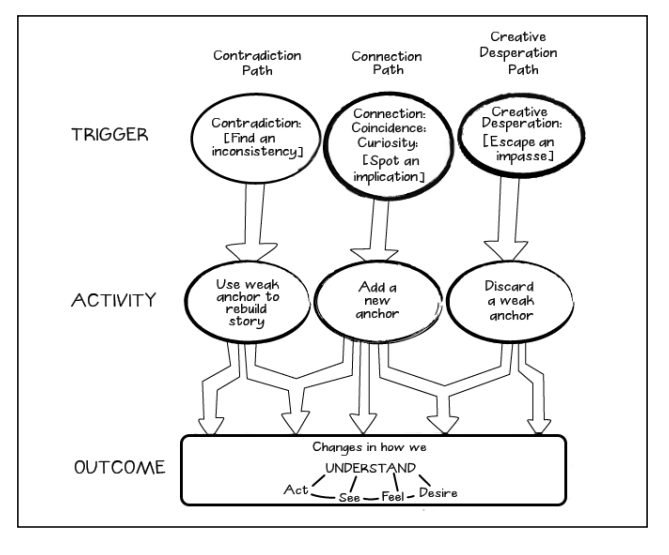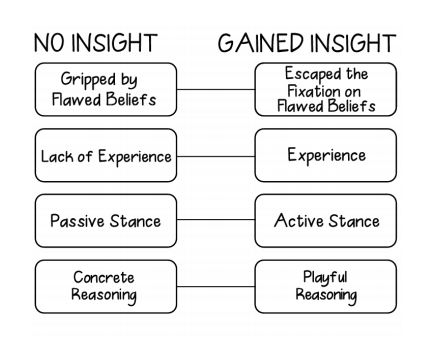
Whether it’s a ground-breaking scientific discovery or a glimpse into our own personal habits and behaviors, what leads people to moments of insight?
Whether it’s a ground-breaking scientific discovery or a glimpse into our own personal beliefs and habits, what leads people to moments of insight?
This is one of the key questions psychologist Gary Klein asks himself in his new book Seeing What Others Don’t: The Remarkable Ways We Gain Insight.
Today, in the field of cognitive psychology, there is a big focus on identifying cognitive biases and reducing errors in our thinking. However, according to Klein, this is only one aspect of becoming a better thinker.
While individuals and organizations like to reduce mistakes in decision-making, another important aspect to cultivate in our thinking is how to increase insight and creativity. However, this question can be a bit trickier and harder to answer.
Gary Klein is a rare type of psychologist because he doesn’t always like to study the mind in controlled experiments and laboratories. Instead, he has pioneered a new field of psychology called “naturalistic decision-making,” where he studies people’s decisions and choices in the real world.
Instead of trying to devise a clever experiment to study insight, he gathered 120 different case studies of people actually making insights in the real world. These case studies included revolutionary thinkers in science, medicine, and technology, as well as everyday people like policemen, firemen, teachers, friends, and family.
In this thought-provoking book, Klein does a great job “digging through the trenches” of different stories describing people’s insights. He then creates a working model of how different insights are created, which he calls the “Triple Path Model of Insight.”
The way Gary Klein defines insight in his book is “an unexpected shift to a better story.” Often when we have insights, it literally changes how we see the world and how we think and feel. Once you have an insight, you can’t take it back, everything that happens after the insight is different in some way.
In his “Triple Path Model of Insight” he describes how different individuals arrive to insights. And while no insight is exactly the same, many insights follow one or more of these paths. Here is a nice diagram of Klein’s “Triple Path Model of Insight.” I’ll elaborate more on each of these different paths below.

The Triple Path Model of Insight
According to psychology researcher Gary Klein, the 3 main paths of insight he discovered are:
-
Contradiction Path – In this path, we notice an inconsistency that doesn’t align with our previous beliefs or assumptions. This path is often a result of anomalies and contradictions, which usually start with us thinking, “This doesn’t make any sense,” and that leads us to re-think the situation. For example, when a police officer discovered someone ashing their cigarette on the floor of a brand new car, it perked the officer’s interest and made them re-evaluate what was going on. What the officer soon realized is that the car must be stolen, because most people wouldn’t think to ash a cigarette on the floor of their brand new car.
Insight Tip #1 – Be willing to explore contradictions and inconsistencies that don’t fit with your current beliefs. A contradiction can often influence you to look at a situation from another perspective before it starts making sense. Klein sometimes calls this the “Tilt Reflex.”
Connections Path – In this path, we notice a connection between 2 things that are seemingly unrelated. This path is often a result of coincidences and curiosities, which usually start with us thinking, “Hm, that’s funny. What’s going on here?” For example, when chemist Osamu Shimomura attended a lecture on jellyfish, he learned about their ability to emit light through bioluminescence. He later extracted the protein that allowed this to happen (green fluorescent protein – GFP), and applied it to studying the insides of other organisms without needing to dissect them (his field of study). Today, GFP is used to detect different types of bacteria, viruses, and pollution inside organisms, and it earned Shimomura a Nobel Prize in Chemistry in 2008.
Insight Tip #2 – Be willing to expose yourself to new things on a regular basis. When you think outside your current discipline and expertise, you can often draw insights from other unexpected places. The connection path thrives on having lots of ideas swirling around and increasing the chance of accidental associations. This is sometimes known as the “Swirl Effect.” (as described in Steven Johnson’s Where Good Ideas Come From)
Creative Desperation Path – In this path, we are often driven to be creative and insightful out of pure desperation. This path is often a result of constraints and limited time. For example, during the Mann Gulch fire of 1949, a group of smokejumpers were trying to outrun a huge forest fire that was spreading quickly. A dozen firefighters died in the incident, but one man who survived had an interesting plan. He decided to create another fire in front of himself to pre-burn a patch of dry grass and then use it as an “island” when the forest fire inevitably spread to him. (literally “fighting fire with fire”).
Insight Tip #3 – The creative desperation path doesn’t have to be a “life or death” situation. You can spur your own creativity and insight by purposely adding constraints and time limitations to your creative process. For example, a musician may try to find new ways of playing an instrument by forcing himself to create a whole album using just one instrument (a planned “constraint” that forces you to think a new way).
What Blocks the Flow of Insights?
While it’s important to be aware of the different paths to insight and what triggers them, it’s also important to minimize the ways we often unintentionally block the flow of insights.
For example, two people may have access to the same information, but for some reason only one of them successfully gets to the insight while the other misses it. What is it that causes the other person to “miss” the insight?
In many of the cases Klein studied, he found a “twin” case in which someone was close to the insight, but never quite grasped it. By looking further into these “twin” cases, he discovered what separated a successful “twin” from an unsuccessful “twin.”
Here’s a diagram illustrating the 4 different factors that Klein found to block insight. I’ll elaborate on each of these below.

-
False Beliefs – One factor that limits the flow of insight is when an individual is gripped by a false belief. When we are fixated on a particular belief, we often downplay or ignore information that goes against it. This makes it much more difficult to correct that belief when we are shown evidence that it is incorrect.
Lack of Experience – Another factor that limits the flow of insight is a lack of experience. Almost everyone that had insights in Klein’s examples had an insight into an area they had been working in for a long time. Without these years of experience to draw from, it’s unlikely a person will stumble upon an insight, since they don’t have enough knowledge to either make meaningful connections nor detect contradictions.
Passive Stance – A third factor that limits the flow of insight is a passive stance. When an individual is confronted with a puzzling question or problem, it’s tempting to give up on it and let someone else figure it out. People who cultivate insights often take a more active and engaged stance, including a hunger to solve the puzzles they encounter.
Concrete Reasoning – The final factor that limits the flow of insight is concrete reasoning. Insight often requires playing with different ideas, including the use of hypothetical situations and “thought experiments.” Too rigid thinking often blocks us from “playing with ideas” that don’t immediately make sense or seem logical.
Seeing What Others Don’t is a really interesting look into the nature of insight and the practical ways we can cultivate more insight in our everyday lives. It’s definitely one of the best books I’ve read on creative thinking this year.
The best part is psychologist Gary Klein walks you through his own experiences studying insight – and eventually how he arrives at his own “insights about insights.” So not only does his book tell different stories of discovering insights, it is a process of insight discovery in-itself.
While it may be a bit controversial among scientists, I appreciate his “naturalistic approach” to studying human decision-making, especially since I find “anti-anecdotalism” to be one of the ideas in psychology that must die.
Often a good story can give us a more detailed look at a phenomenon we wish to learn more about. This book is chockfull of good stories about insight, combined with both a healthy dose of skepticism and introspection.
Enter your email to stay updated on new articles in self improvement:
